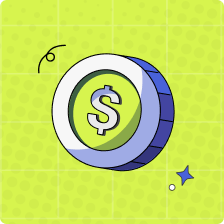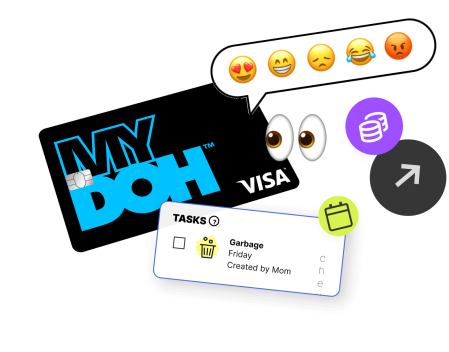Let’s face it – back-to-school shopping can often feel less like a team effort and more like a tug-of-war. On one side: kids with big dreams (and even bigger wishlists). On the other: parents trying to stick to a budget without totally dampening their kids’ excitement about returning to school.
No wonder 81% of Canadian parents say they find back-to-school shopping “stressful”, according to a new study commissioned by Mydoh, the money management app for kids and teens.
But what if back-to-school season didn’t have to be a battle? What if it could be an opportunity to teach kids smart money habits?
That’s why Mydoh has teamed up with financial expert Jessica Moorhouse to bring Canadian families real-life advice to navigate the shopping season with less stress and more confidence. Think of us as your secret weapon for empowering kids, setting spending boundaries, and maybe – just maybe – making back-to-school shopping fun again.

Before You Go
A little planning can play a big role in helping tame the wishlist wars. Here’s how to get your kids in the right money mindset before you hit the mall.
Build the Budget Together
One in three parents Mydoh talked to about back-to-school shopping said they often spend more than their planned budget because they never built a budget in the first place!
Taking the time to write down what you need to buy and how much you plan to spend during such a significant shopping season is critical – and it’s not a process parents should undertake alone. Researching the prices of items ahead of time can help shape a realistic budget and empower kids to understand the value of what they’re asking for.
“When kids feel like collaborators,” explains Moorhouse, “they’re far more likely to stick to the plan and respect the limits. After all, it’s easier to follow the rules when you’ve helped write them.”
Adjust Your Approach By Age
Kids as young as grade one or two can be involved in the budgeting process – but the approach will vary based on age.
For kids up to grade four, parents can take the lead, but kids should review the list. Try asking questions like, “Here is what we’ve put on the list, is there anything we’re missing?” It can be helpful to talk about budgeting in a way kids can easily understand – encourage them to think of spending like credits in a video game.
Around grade five, start to involve kids more directly in building the budget. Walk kids through the breakdown: how much goes to categories like clothes, school supplies and tech? Do a mini audit of last year’s purchases to identify what still fits or works – is there anything from the previous year they can re-use? Think of it like math class – show your work so they can understand the bigger financial picture.
Differentiate Wants and Needs
When kids add things to the shopping list, talk the items through. You can discuss each item and really try to understand why your child might want it. From there, decide as a team if the item is a want or a need. At this stage, it’s also a great idea to prioritize the items on each list – just in case you’re not able to get to everything!
Give kids transparency into what your back-to-school budget is, and offer them the opportunity to use their own money – earned through allowance, gifts or any work they do – to pay for some of the “wants” themselves.
This is where a tool like Mydoh can help: the app’s “Spend” and “Save” features are perfect to help with goal-oriented saving. Kids can specifically set money aside for the cool running shoes or new piece of tech they’re eyeing – and it won’t be available for them to spend. They can even have their allowance automatically split between these features as soon as it comes in, making saving effortless.
At The Store
You know what they say about the best-laid plans? 60% of parents surveyed by Mydoh say their kids have a basic understanding of the financial realities of back-to-school shopping – but that those realities are easily forgotten once they walk into a store.
Shift the Mindset: Sticking to the Budget is a Critical Life Skill
40% of parents polled said they overspend during back-to-school shopping because they don’t want to disappoint their kids. But it’s so important to remember that setting boundaries doesn’t make you a “bad parent” – it actually helps build long-term financial fortitude in your kids.
“The biggest financial mistake I see parents make during the back-to-school season is allowing their kids to make the rules and dictate the spending,” says Moorhouse. “You’re the parent. You need to set the tone, and model the lessons you’re trying to deliver.”
Validate the Want. Redirect the Conversation
According to Mydoh’s research, one in three Canadian parents go over budget because they give in to pressure from their kids once they’re in the store.
When kids ask for something outside the budget, don’t judge or dismiss them – but don’t just default to yes, either. Instead, validate the want – and offer them choices: “Would you rather wait and save up, or swap something else out?”
Give Kids Autonomy
If you’ve identified some items your kids are responsible for purchasing as part of the budgeting process, give them the opportunity to take control of their spending in the store.
Ensure they have their own way to pay – like using the Smart Cash Card, which is included with every Mydoh account and can be used both in-store and online. Parents stay informed through real-time transaction notifications – and have the ability to lock the card in the event that the card or phone gets lost, which means you can even send your kids out to do some shopping on their own, and still enjoy both oversight and peace of mind.
Once You Get Home
Sticking to a plan and a budget means there’s a good chance you’ll come home from back-to-school shopping without buying everything your child wanted. But the end of the shopping trip doesn’t need to be the end of the story.
Encourage Ongoing Earning
Use a tool like Mydoh to teach kids the value of earning money through effort by assigning regular tasks or chores that reward them with payments upon completion. When you take your child back to the store a few weeks later to finally pick up the coveted item, they’ll have learned a valuable lesson: some “wants” take time and dedication to achieve.
About Mydoh
Since 2019, Mydoh has been committed to helping parents raise money-smart youth. Mydoh began with the shared belief that money management isn’t something you are taught, as much as something you learn through experience – and that experience should start early. Mydoh has championed this belief since its inception and with it, has been able to help over 260,000 Canadians build a more solid financial foundation for the next generation.
Survey Methodology
These findings are drawn from an online survey conducted by Prodege/Pollfish between July 25 – 27, 2025, on behalf of Mydoh. The survey included a total of n=1,000 Canadian parents with children aged 7-15. Respondents fell out naturally in terms of demographic characteristics, but quotas were used to ensure that n=200 responses were collected in Quebec and enable reliable segmentation of the results. At a sample size of 1,000, the margin of error for the study is ± 3.1 percentage points at a 95% confidence level, though margins of error are higher among subsets of the population. All sample surveys and polls may be subject to other sources of error, including, but not limited to, coverage error and measurement error.
This article is intended as general information only and is not to be relied upon as constituting legal, financial or other professional advice. A professional advisor should be consulted regarding your specific situation. The information presented is believed to be factual and up-to-date but we do not guarantee its accuracy and it should not be regarded as a complete analysis of the subjects discussed. All expressions of opinion reflect the judgment of the authors as of the date of publication and are subject to change. No endorsement of any third parties or their advice, opinions, information, products or services is expressly given or implied by Royal Bank of Canada or any of its affiliates.
This article offers general information only and is not intended as legal, financial or other professional advice. A professional advisor should be consulted regarding your specific situation. While the information presented is believed to be factual and current, its accuracy is not guaranteed and it should not be regarded as a complete analysis of the subjects discussed. All expressions of opinion reflect the judgment of the author(s) as of the date of publication and are subject to change. No endorsement of any third parties or their advice, opinions, information, products or services is expressly given or implied by Royal Bank of Canada or its affiliates.

















